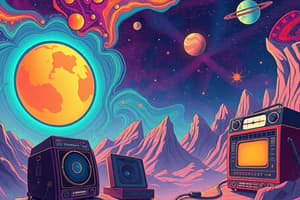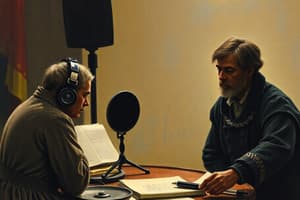Podcast
Questions and Answers
What role did Song Pluggers play in the music industry?
What role did Song Pluggers play in the music industry?
- They showcased new songs in stores for public exposure. (correct)
- They managed famous artists' careers.
- They produced live concerts for large audiences.
- They recorded performances for albums.
How did the invention of the microphone impact vocalists like Bing Crosby and Frank Sinatra?
How did the invention of the microphone impact vocalists like Bing Crosby and Frank Sinatra?
- It helped them reach larger audiences with clarity. (correct)
- It forced them to change their singing styles.
- It led to the decline of live performances.
- It limited their vocal range.
Which combination of instruments defined the rhythm section in Big Band music?
Which combination of instruments defined the rhythm section in Big Band music?
- Harmonica, flute, clarinet.
- Violin, tambourine, accordion.
- Bass, drums, piano, guitar. (correct)
- Guitar, saxophone, trumpet.
What significant contributions did Les Paul make to music?
What significant contributions did Les Paul make to music?
Which statement correctly describes Country and Western music?
Which statement correctly describes Country and Western music?
What influence did Louis Jordan have on the Rhythm & Blues genre?
What influence did Louis Jordan have on the Rhythm & Blues genre?
Which of the following artists is recognized for their contributions to Country Music?
Which of the following artists is recognized for their contributions to Country Music?
What was a characteristic feature of Chicago Electric Blues?
What was a characteristic feature of Chicago Electric Blues?
Which artist is known for the song 'Be My Baby'?
Which artist is known for the song 'Be My Baby'?
Who was a significant crossover artist in the transition of R&B to mainstream pop?
Who was a significant crossover artist in the transition of R&B to mainstream pop?
Which musical style combined elements of Country & Western with Rock & Roll?
Which musical style combined elements of Country & Western with Rock & Roll?
What was a defining characteristic of Folk music that gained popularity among college students?
What was a defining characteristic of Folk music that gained popularity among college students?
Which of the following artists is associated with the Motown label?
Which of the following artists is associated with the Motown label?
Which band is known for the song 'I Want to Hold Your Hand'?
Which band is known for the song 'I Want to Hold Your Hand'?
Who is associated with the hit song 'Stand By Me'?
Who is associated with the hit song 'Stand By Me'?
Which artist's style is often characterized by taking inspiration from psychedelia?
Which artist's style is often characterized by taking inspiration from psychedelia?
What song is associated with the artist Buddy Holly?
What song is associated with the artist Buddy Holly?
Which of the following is NOT typically associated with the characteristics of Girl Group music?
Which of the following is NOT typically associated with the characteristics of Girl Group music?
Which artist is known for the song 'Respect'?
Which artist is known for the song 'Respect'?
What influenced the rise of the 'surf music' genre, represented by The Beach Boys?
What influenced the rise of the 'surf music' genre, represented by The Beach Boys?
Which artist was instrumental in pioneering Rock & Roll with hit songs like 'Johnny B. Goode'?
Which artist was instrumental in pioneering Rock & Roll with hit songs like 'Johnny B. Goode'?
Flashcards
Big Band Era
Big Band Era
The period in American music history when large ensembles, including a rhythm section, horns, and vocalists, dominated popular music. It thrived from the 1930s to the late 1940s.
Overdubbing
Overdubbing
A recording technique that allows multiple layers of music to be recorded separately and then combined in a single track.
Crooner
Crooner
A male singer characterized by a smooth and emotional vocal style, especially in a soft, low-pitched voice.
Country Music
Country Music
Signup and view all the flashcards
Western Music
Western Music
Signup and view all the flashcards
Rhythm & Blues (R&B)
Rhythm & Blues (R&B)
Signup and view all the flashcards
Jump Blues
Jump Blues
Signup and view all the flashcards
Microphone
Microphone
Signup and view all the flashcards
Rock and Roll
Rock and Roll
Signup and view all the flashcards
Rockabilly
Rockabilly
Signup and view all the flashcards
Teen Idol Pop
Teen Idol Pop
Signup and view all the flashcards
Folk Music
Folk Music
Signup and view all the flashcards
Girl Group Pop
Girl Group Pop
Signup and view all the flashcards
Soul Music
Soul Music
Signup and view all the flashcards
Surf Music
Surf Music
Signup and view all the flashcards
British Invasion
British Invasion
Signup and view all the flashcards
Electric Folk
Electric Folk
Signup and view all the flashcards
Motown
Motown
Signup and view all the flashcards
Chicago Sound
Chicago Sound
Signup and view all the flashcards
Stax Records
Stax Records
Signup and view all the flashcards
Psychedelic Music
Psychedelic Music
Signup and view all the flashcards
Counterculture Music
Counterculture Music
Signup and view all the flashcards
Rhythm and Blues (R&B)
Rhythm and Blues (R&B)
Signup and view all the flashcards
Study Notes
Radio's Role in Music Dissemination
- Music was initially regional, heard locally at places like Five & Dime stores by song pluggers.
- Early records made performances accessible.
- Broadway musicals helped popularize songs.
- Radio, initially for military use, eventually connected the nation through artists' recordings.
The Microphone's Impact
- Thomas Edison and David Edward Hughes' inventions converted sound into amplifiable signals.
- This improved recording clarity compared to earlier horn-based phonographs.
- Vocalists like Bing Crosby and Frank Sinatra gained greater fame, using microphones to reach wider audiences.
Crooners
- Crooners are male singers who sing sentimental songs in soft, low voices.
- Examples include Frank Sinatra (Fly Me to the Moon) and Bing Crosby.
The Big Band Era
- Big bands used rhythm sections (bass, drums, piano, guitar) combined with horn sections (trumpets, trombones, saxophones) for dancing music.
- Key figures included Count Basie, Tommy & Jimmy Dorsey, Duke Ellington (Take the A Train), Benny Goodman, and Glen Miller (String of Pearls).
Les Paul's Innovations
- Les Paul invented the solid-body guitar.
- He also pioneered overdubbing ("sound-on-sound recording").
Regional Country and Western Music
- Country music emerged from southeast and Appalachian folk styles.
- Western music originated in western and southwest styles.
- Key figures: Gene Autry, The Carter Family (Can the Circle Be Unbroken), Jimmie Rogers, and Hank Williams.
Rhythm and Blues (R&B)
- Louis Jordan and his Tympani Five popularized Jump Blues, influenced by big band fast tempos.
- R&B was heavily influenced by gospel music.
- Chicago Electric Blues featured intense vocals (e.g., Muddy Waters, Little Walter, Bo Diddley).
- Atlantic and Black Pop focused on singers (e.g., Ray Charles, Ruth Brown, Big Joe Turner).
- Doo-Wop consisted of a cappella vocal arrangements with nonsense syllables.
The Birth of Rock & Roll
- R&B music started crossing over to pop charts, marking a new phenomenon focused on teenagers.
- Early crossover artists include Fats Domino and Chuck Berry (Johnny B. Goode).
- Little Richard was another key figure in this era.
The "Whitening" of R&B
- Some bands adapted R&B to a more palatable form for mainstream audiences, adjusting lyrics and rhythm to a new Rock and Roll model.
- Examples include Bill Haley and the Comets.
Elvis Presley
- Elvis Presley emerged from the Memphis blues scene, which had a large black music presence.
- His Louisiana Hayride performance launched his career.
- RCA paid a record $35,000 for his contract.
Rockabilly
- Rockabilly combined elements of country and western with rock and roll.
- Key figures: Carl Perkins, Johnny Cash (Ring of Fire), Jerry Lee Lewis, Gene Vincent, and Brenda Lee, Buddy Holly.
Teen Idols
- Music marketed "clean-cut, respectable" young men for dating.
- This type of music was sometimes called "bubblegum" music.
- Examples include Frankie Avalon, Bobby Darin, and Bobby Vinton.
Rockabilly Pop
- This genre combined rockabilly elements with pop sensibilities, particularly focusing on mainstream lyrics.
- Examples include Roy Orbison (Cryin'), the Everly Brothers, and Ricky Nelson.
Folk Music
- Folk music arose among college students, addressing social issues in a less pretentious, accessible way.
- Key figures: Bob Dylan, The Kingston Trio and Peter, Paul, and Mary (Leavin' on an Airplane/Puff the Magic Dragon)
Girl Groups
- 1960s girl groups produced formulaic, "wholesome" teen pop music.
- Key acts: The Shirelles, The Ronettes (Be My Baby), and The Supremes.
Soul Music
- Soul music evolved from R&B, using gospel vocalists and incorporating R&B elements.
- Notable figures: Sam Cooke, Ben E. King (Stand By Me), and Dionne Warwick.
The Beach Boys
- Influenced by Chuck Berry, they created surf music for teenagers.
- Notable examples: Fun, Fun, Fun and Surfin' USA
Other Surf Bands
- Surf music was popularized by diverse artists including Jan & Dean, Dick Dale, and The Safaris
The British Invasion/The Beatles
- Post-WWII British Skiffle music influenced The Beatles, launching the British Invasion.
- Key acts include The Beatles (Please Please Me, I Want to Hold Your Hand, She Loves You), The Rolling Stones, The Who, and The Animals.
Electric Folk
- Bob Dylan's use of electric instruments sparked criticism and inspired other bands (The Byrds, The Turtles, The Mamas and the Papas).
Motown
- Motown, established by Berry Gordy, produced major artists like The Supremes (Stop! In the Name of Love), Marvin Gaye, and Stevie Wonder (For Once in My Life).
Chicago Sound
- Chicago was a hub for electric blues and gospel-influenced soul.
- Key figures include Etta James, Jackie Ross, Little Milton, and the Dells.
Southern/Memphis Connection
- Stax Records, licensed by Atlantic, brought artists like Otis Redding (Sittin' on the Dock of the Bay), Sam & Dave (Hold On, I'm Comin'), and Wilson Pickett.
Aretha Franklin
- Aretha's father was a well-known preacher, influencing her music.
- Key hits include "Respect."
Psychedelia
- Psychedelia embraced experimentation, challenging societal values and exploring topics of religion and philosophy, fueled by LSD use in the Haight-Ashbury neighborhood.
- Key acts: The Grateful Dead, Jefferson Airplane ("White Rabbit"), Jimi Hendrix (The Jimi Hendrix Experience, "Are You Experienced?"), Janis Joplin (with Big Brother & the Holding Company).
Studying That Suits You
Use AI to generate personalized quizzes and flashcards to suit your learning preferences.
Description
Explore the evolution of music dissemination through radio and the microphone's role in enhancing vocal performances. This quiz delves into the significant eras of music, including the rise of crooners and the Big Band era, featuring iconic artists like Bing Crosby and Frank Sinatra. Test your knowledge on how these innovations shaped the music industry.




